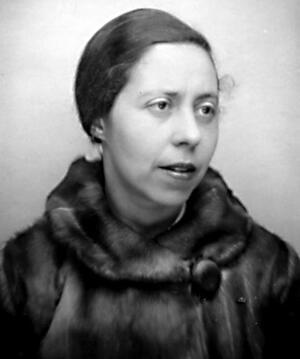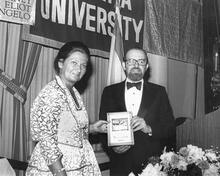Irene Nemirovsky
Murdered during the Holocaust, novelist Irène Némirovsky finally achieved the recognition she deserved long after her death. Némirovsky’s family fled the Russian Revolution and settled in France in 1919. She studied at the Sorbonne and began writing at eighteen. She published her first novel, L’Enfant Genial, in 1927. Her next two novels, David Golder (1929) and Le Bal (1930), were great successes and were adapted for the screen. Despite her literary achievements and popular acclaim, she struggled with antisemitism and converted to Catholicism in 1939. In 1942 she was sent to Auschwitz, where she died of typhus. In 1990 her daughter Elisabeth Gille published Némirovsky’s Suite Française, a novel about the invasion of Paris. The novel won the Prix Renaudot in 2004, a first for a posthumous author.
The story of Irène Némirovsky’s life is as complex, captivating, and heartbreaking as any of her numerous novels, yet this story would have remained hidden from history if not for a controversial and unprecedented panel decision that rocked the French literary establishment in November 2004. Sixty-two years after it was written, Némirovsky’s epic of France in the first years of the German Occupation, Suite Française (French Suite), received the prestigious Prix Renaudot (previously given only to living authors and second in importance to the Prix Goncourt), turning the spotlight back onto this extraordinarily talented novelist and the tragedy of a career cut short by the Holocaust. In 1942, soon after she was arrested and deported to Auschwitz (on Convoy Number 6, July 17, one of the first convoys out of France immediately after the Vel d’Hiv roundup), Nemirovsky died of typhus at the age of thirty-nine, leaving behind two little girls and a literary legacy whose astonishing breadth and sensitivity suggest comparisons with Balzac and Tolstoy.
Early Life and Family
Irène Némirovsky was born in Kyiv, Ukraine, in 1903, into a family of Jewish bankers. Her father Leon was one of the richest financiers in Russia and she grew up surrounded by wealth and elegance in St. Petersburg. After the Bolshevik Revolution the family emigrated first to Finland and then to Sweden, in 1919 finally settling in France, where Irene was determined to resume the active social life of her childhood and to succeed in a career as a writer. She accomplished both with characteristic brilliance, becoming one of the most talented and celebrated authors of her day, a hugely popular and critically acclaimed writer who was warmly welcomed into the most distinguished circles of the Parisian literati.
Early Career, Conversion to Catholicism, and World War II
Némirovsky had earned a licence de lettres at the Sorbonne in 1926 (she became fluent in French and maintained her prolific career in that language), a year that also saw the publication of her first novel, Le Malentendu (although she had been publishing short stories and novellas since 1923). That same year she married Michel Epstein, a Russian emigré and banker; they had two daughters, Denise, born in 1929 and Elisabeth, in 1937. A thriving young family and a highly active public life did not hamper her creative energy, and during the 1930s Nemirovsky produced two best-selling novels that quickly became feature films: David Golder in 1929 (starring Harry Baur in Julien Duvivier’s first sound film about an unhappy Jewish patriarch and businessman) and Le Bal in 1930 (adapted to film in 1931, starring Danielle Darrieux in her screen debut as a sensitive young woman who despises the greed of the nouveaux riches). While the former novel offers an astute portrait of an entire age on a grand scale, the latter details an intimate and complex relation between a mother and daughter. Némirovsky was equally adept at large canvases and miniatures. In addition to over a dozen novels, she wrote a comprehensive biography of Chekhov that was published posthumously in 1946, consolidating a reputation that was already well-established by the time of Némirovsky’s arrest.
After France declared war on Germany in September 1939, Némirovsky hastily had her two daughters baptized into the Catholic church and sent them to safety in the village of Issy-l’Eveque, where their nanny’s mother lived. Once Germany invaded and conquered France in June 1940, Némirovsky found she had lost the support of her editors and friends; wearing the yellow star, she joined her daughters, as did their father the following year, since as a foreign-born Jew he had lost his right to work. It was in this village and this atmosphere that Némirovsky began to outline her five-part epic novel, inspired by War and Peace and eerily foreshadowing the end that was to come. Of the five sections, “Storm in June,” “Dolce,” “Captivity,” “Battle,” and “Peace,” only the first two were completed, one dealing with the flight of Jews from Paris during the great exodus of 1940, the other with the early period of German occupation. In July 1942, just days after finishing the second volume, Irène was arrested in front of her girls and almost immediately deported to the East. After a desperate campaign to secure her release, her husband was himself arrested just two months later and was gassed upon arrival at Auschwitz.
Thirteen-year-old Denise and five year-old Elisabeth owe their lives to one of the French gendarmes who came to arrest their father: he told them to run home, grab what they could, and disappear. What they took, a small suitcase containing manuscripts in tiny handwriting, some clothing, photographs, diaries—“I did not know what it was, but I knew it was precious to mother,” says Denise—turned out to be the text of the first two volumes of Suite Française. The girls survived by being hidden by a teacher, friends, and a governess who guided them through convents, safe houses, and the like until after the war, when they realized that both parents had perished. In 1992 the younger daughter, Élisabeth Gille, published a biography of her mother entitled Le Mirador, for which she used some of the letters found in the suitcase. The tiny writing had to be deciphered with a magnifying glass, the project complicated for the two sisters by the enormous sense of loss these writings evoked. Even after the publication of this imaginary memoir (Élisabeth died in 1996), Denise put the texts in a drawer, finding it too painful to read her mother’s last words. However, in April 2004 Denise met Myriam Anissimov, who had written biographies of Primo Levi and Roman Gary, the latter a family friend of Irène’s. It was Anissimov who realized that far from being a personal journal, these writings were two complete novels, and she arranged for their publication in 2004.
Translation rights have been obtained by eighteen countries and the book—an unsentimental account of a French village under occupation—has been hailed as a masterpiece, a modern classic that combines the authenticity of lived experience with the imagination of an incredibly articulate and perceptive observer. Some commentators regard it as the most important descriptive wartime writing since Anne Frank’s diaries. Because it details a very painful moment in French contemporary history, and because it so powerfully evokes a period that has only recently been explored rather than repressed, Némirovsky’s writing occupies a unique place in world literature. But it is Denise’s assessment that captures the peculiar rhythm of intimacy and distance that will make Némirovsky’s writing endure: “She could look inside the human soul and make music with her words. But it is only now that I can look at it as a reader rather than as my mother’s daughter.”
Selected Works by Irène Némirovsky
Chaleur du sang (Fire in the Blood, 2007 [English translation by Sandra Smith, 2007]).
Suite Française (French Suite, 2004. [English translation by Sandra Smith, 2006]).
Destinées et autres nouvelles (Destinies and other novellas, 2004).
Dimanche (nouvelles) (Sunday, novellas, 2000).
Les feux de l’automne (Autumn Fires, 1957).
Les biens de ce monde (Worldly Goods, 1947).
La vie de Tchekhov (Life of Chekhov, 1946).
Les chiens et le loup (The Dogs and the Wolf, 1940).
Deux (Two, 1939).
La proie (The Prey, 1938).
Jezabel (1936).
Le vin de solitude (The Wine of Solitude, 1935).
Films parlés (Talking Pictures, 1934).
Le pion sur l’echiquier (The Pawn on the Chessboard, 1934).
L’Affaire Courilof (The Courilof Affair, 1933).
Les mouches d’automne (The Autumn Flies, 1931).
Le bal (The Ball, 1930).
David Golder (1929).
L’Enfant géniat (The Child Genius, 1927).
Le Malentendu (The Misunderstood, 1926).
Jaillant, Lise. “A Masterpiece Ripped from Oblivion: Rediscovered Manuscripts and the Memory of the Holocaust in Contemporary France.” Clio 39:3 (Summer 2010): 359-379.
Kershaw, Angela. Before Auschwitz: Irène Némirovsky and the Cultural Landscape of Inter-war France. New York: Routledge, 2009.
Phillipponnat, Olivier and Patrick Lienhardt. The Life of Irène Némirovsky, 1903-1942. New York: Alfred A. Knopf, 2010.
Suleiman, Susan Rubin. The Némirovsky Question: The Life, Death, and Legacy of a Jewish Writer in Twentieth-Century France. New Haven: Yale University Press, 2016.
Weiss, Jonathan M. Irène Némirovsky: Her Life and Works. Stanford: Stanford University Press, 2007.




